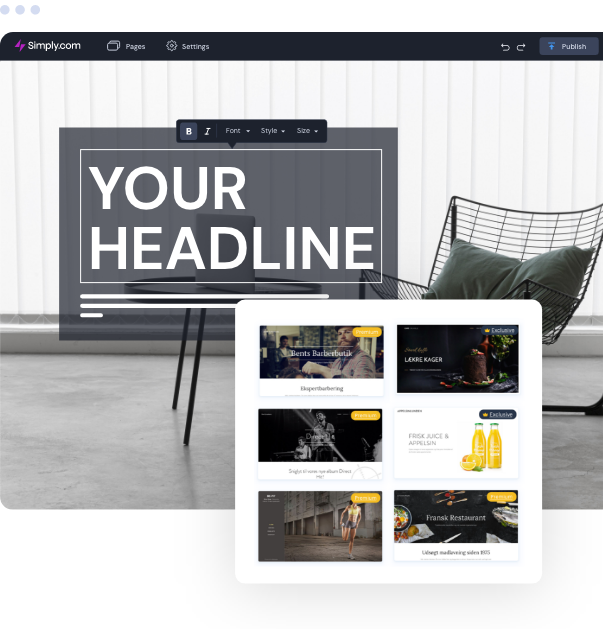Top Web Design Singapore Solutions for a Powerful Online Presence
Wiki Article
Top Trends in Site Layout: What You Need to Know
As the landscape of website design remains to develop, understanding the current patterns is necessary for creating effective and interesting online experiences. Minimalism, dark mode, and mobile-first strategies are amongst the vital styles forming modern-day style, each offering special advantages in individual interaction and performance. Furthermore, the emphasis on availability and inclusivity highlights the importance of creating electronic environments that accommodate all users. However, the effects of these fads go beyond visual appeals; they represent a shift in just how we view customer communication. What various other aspects are affecting these design choices today?Minimalist Layout Appearances
In current years, minimal style aesthetics have actually become a leading trend in website style, stressing simpleness and performance. This approach prioritizes crucial content and gets rid of unneeded aspects, therefore boosting individual experience. By focusing on clean lines, ample white space, and a minimal shade palette, minimalist designs promote simpler navigating and quicker load times, which are vital in preserving users' attention.Typography plays a significant function in minimalist style, as the choice of font can stimulate certain emotions and lead the user's journey via the web content. The strategic use of visuals, such as high-quality images or refined computer animations, can boost individual interaction without overwhelming the overall aesthetic.
As digital areas remain to progress, the minimalist layout principle remains pertinent, providing to a diverse target market. Companies embracing this fad are usually regarded as modern and user-centric, which can substantially influence brand assumption in an increasingly open market. Ultimately, minimal style aesthetic appeals provide an effective option for reliable and attractive website experiences.
Dark Setting Popularity
Accepting a growing fad amongst customers, dark mode has gotten significant appeal in website style and application interfaces. This design approach includes a predominantly dark color scheme, which not only enhances visual allure however also lowers eye stress, especially in low-light settings. Customers increasingly appreciate the comfort that dark setting provides, bring about much longer engagement times and an even more delightful surfing experience.The fostering of dark mode is also driven by its regarded advantages for battery life on OLED displays, where dark pixels eat much less power. This useful advantage, integrated with the stylish, contemporary appearance that dark styles give, has led lots of developers to incorporate dark mode alternatives right into their projects.
Additionally, dark setting can develop a feeling of depth and focus, drawing attention to crucial aspects of a web site or application. web design company singapore. Therefore, brands leveraging dark setting can boost customer interaction and produce a distinct identification in a crowded industry. With the pattern continuing to increase, including dark mode into web designs is coming to be not simply a choice however a typical assumption among customers, making it necessary for developers and developers alike to consider this aspect in their tasks
Interactive and Immersive Elements
Frequently, designers are integrating interactive and immersive elements into websites to enhance customer interaction and produce unforgettable experiences. This fad reacts to the raising assumption from users for more vibrant and personalized communications. By leveraging features such as computer animations, videos, and 3D graphics, sites can attract customers in, cultivating a deeper connection with the material.Interactive elements, such as quizzes, surveys, and gamified experiences, urge site visitors to actively participate as opposed to passively eat details. This involvement not just keeps individuals on the site longer however also boosts the possibility of conversions. In addition, immersive technologies like online truth (VR) and increased fact (AR) offer unique chances for services to display products and solutions in an extra engaging manner.
The unification of micro-interactions-- tiny, refined animations that react to user activities-- likewise plays an important duty in improving usability. These communications supply responses, enhance navigation, and develop a feeling of contentment upon conclusion of jobs. As the digital landscape continues to progress, using interactive and immersive aspects will remain a considerable emphasis for designers intending to develop engaging and effective online experiences.
Mobile-First Approach
As the occurrence of smart phones proceeds to surge, embracing a mobile-first strategy has come to be necessary for web designers aiming to optimize user experience. This technique stresses developing for mobile gadgets prior to scaling up to bigger screens, making sure that the core performance and content are easily accessible on one of the most generally used system.One of the primary benefits of a mobile-first strategy is improved efficiency. By concentrating on mobile layout, web sites are structured, lowering lots times and enhancing navigating. This is specifically important as individuals anticipate quick and receptive experiences on their mobile phones and tablets.

Ease Of Access and Inclusivity
In today's digital landscape, making certain that internet sites come and inclusive is not just a finest technique however an essential demand for getting to a diverse target market. As the internet continues to work as a key ways of communication and commerce, it is vital to identify the different demands of individuals, including those with disabilities.To accomplish true access, web designers should follow developed guidelines, such as the Internet Web Content Accessibility Guidelines (WCAG) These standards emphasize the relevance of supplying text options for non-text web content, making certain key-board navigability, and maintaining a logical content framework. In addition, comprehensive layout techniques expand beyond conformity; they include creating a user experience that accommodates numerous capabilities and preferences.
Integrating attributes such as flexible message sizes, shade contrast alternatives, and display reader compatibility not just enhances functionality for individuals with disabilities however also improves the experience for all users. Eventually, focusing on availability and inclusivity fosters an extra equitable electronic atmosphere, motivating more comprehensive engagement and engagement. As businesses progressively recognize the moral and financial imperatives of inclusivity, integrating these principles right into website layout will come to be a crucial element of effective online strategies.
Final Thought

Report this wiki page